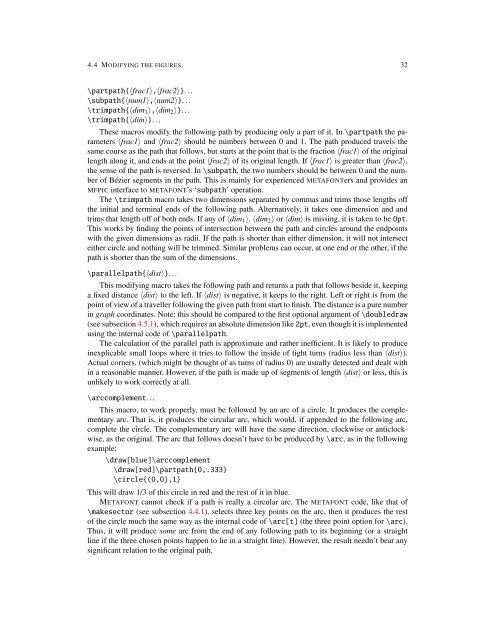Create successful ePaper yourself
Turn your PDF publications into a flip-book with our unique Google optimized e-Paper software.
4.4 MODIFYING THE FIGURES. 32<br />
\partpath{〈frac1〉,〈frac2〉}. . .<br />
\subpath{〈num1〉,〈num2〉}. . .<br />
\trimpath{〈dim 1 〉,〈dim 2 〉}. . .<br />
\trimpath{〈dim〉}. . .<br />
These macros modify the following path by producing only a part of it. In \partpath the parameters<br />
〈frac1〉 and 〈frac2〉 should be numbers between 0 and 1. The path produced travels the<br />
same course as the path that follows, but starts at the point that is the fraction 〈frac1〉 of the original<br />
length along it, and ends at the point 〈frac2〉 of its original length. If 〈frac1〉 is greater than 〈frac2〉,<br />
the sense of the path is reversed. In \subpath, the two numbers should be between 0 and the number<br />
of Bézier segments in the path. This is mainly for experienced METAFONTers and provides an<br />
MFPIC interface to METAFONT’s ‘subpath’ operation.<br />
The \trimpath macro takes two dimensions separated by commas and trims those lengths off<br />
the initial and terminal ends of the following path. Alternatively, it takes one dimension and and<br />
trims that length off of both ends. If any of 〈dim 1 〉, 〈dim 2 〉 or 〈dim〉 is missing, it is taken to be 0pt.<br />
This works by finding the points of intersection between the path and circles around the endpoints<br />
with the given dimensions as radii. If the path is shorter than either dimension, it will not intersect<br />
either circle and nothing will be trimmed. Similar problems can occur, at one end or the other, if the<br />
path is shorter than the sum of the dimensions.<br />
\parallelpath{〈dist〉}...<br />
This modifying macro takes the following path and returns a path that follows beside it, keeping<br />
a fixed distance 〈dist〉 to the left. If 〈dist〉 is negative, it keeps to the right. Left or right is from the<br />
point of view of a traveller following the given path from start to finish. The distance is a pure number<br />
in graph coordinates. Note: this should be compared to the first optional argument of \doubledraw<br />
(see subsection 4.5.1), which requires an absolute dimension like 2pt, even though it is implemented<br />
using the internal code of \parallelpath.<br />
The calculation of the parallel path is approximate and rather inefficient. It is likely to produce<br />
inexplicable small loops where it tries to follow the inside of tight turns (radius less than 〈dist〉).<br />
Actual corners, (which might be thought of as turns of radius 0) are usually detected and dealt with<br />
in a reasonable manner. However, if the path is made up of segments of length 〈dist〉 or less, this is<br />
unlikely to work correctly at all.<br />
\arccomplement. . .<br />
This macro, to work properly, must be followed by an arc of a circle. It produces the complementary<br />
arc. That is, it produces the circular arc, which would, if appended to the following arc,<br />
complete the circle. The complementary arc will have the same direction, clockwise or anticlockwise,<br />
as the original. The arc that follows doesn’t have to be produced by \arc, as in the following<br />
example:<br />
\draw[blue]\arccomplement<br />
\draw[red]\partpath{0,.333}<br />
\circle{(0,0),1}<br />
This will draw 1/3 of this circle in red and the rest of it in blue.<br />
METAFONT cannot check if a path is really a circular arc. The METAFONT code, like that of<br />
\makesector (see subsection 4.4.1), selects three key points on the arc, then it produces the rest<br />
of the circle much the same way as the internal code of \arc[t] (the three point option for \arc).<br />
Thus, it will produce some arc from the end of any following path to its beginning (or a straight<br />
line if the three chosen points happen to lie in a straight line). However, the result needn’t bear any<br />
significant relation to the original path.

















